|
 |
|
The Development of Local
Government
For several hundred years,
Tipton was governed by the Parish Vestry, which by
its very nature favoured ecclesiastical matters
rather than the day-to-day administration of the
town. A vestry meeting would be called by the
churchwardens with the permission of the minister.
The Vestry was the decision making body, named after the room where meetings were held.
In the early years of the 17th century, The Poor
Law, consisting of a series of Parliamentary Acts
came into effect. It defined how a parish would care
for the poorer members of society who were in need
of financial or other assistance. The law was
administered at Vestry meetings that were attended
by the parish ratepayers who could vote by a show of
hands. The Poor Law was replaced by Poor Law Unions
in 1834 (Poor Law Amendment Act of 1834) and Tipton
became part of the Poor Law Union of Dudley, which
also included Rowley Regis and Sedgley. The
principal Dudley Union Workhouse and the Board Room
were in Dudley. The union also used the old
workhouse at Sedgley and the old workhouse at
Tipton, which was in an old half-timbered building
in Church Lane.
The first meeting of the governing body, the
Board of Guardians was held in Dudley Town Hall on
15th October, 1836. It had ten members from Dudley,
eight members from Sedgley, six members from Tipton,
and four from Rowley Regis. Tipton’s first Guardians of
the poor were Philip Williams, John York, Richard
Haines, Richard Nicklin, Simeon Round, and Thomas
Morris.
In June 1832 the town’s first
cholera epidemic began. The population at the time
was around 15,000. There were 1,452 cases of the
disease, affecting nearly ten percent of the
inhabitants. There were 404 deaths before the
disease disappeared. The last local case was
reported in Dudley on 29th November. A national
relief fund had been set up to help sufferers.
Tipton received £929 from the fund which was shared
among the sufferers.
On 3rd August, 1832 a Board of Health or Sanitary
Committee was set up at a Vestry meeting to deal
with the cholera epidemic. The Board was given a
working capital of £300. At a Vestry meeting on 14th
September it was noted that a public subscription
had been organised to help sufferers and that a
management committee had been appointed. The members
were as follows:
William Johnson from Gospel Oak
G. R. Hickman from Moat Colliery
Isaac Shepherd from Toll End Ironworks
Thomas Horton from Toll End Furnaces
William Holland from Sheepwash Lane
Robert Sylvester from Eagle Furnace
Thomas Shorthouse from Church Lane
Charles Birch from Burnt Tree
Edward Cresswell from Parker’s Work |
Cholera returned to Tipton in 1848. From October
of that year, until December 1849, there were 113
deaths in the town, from the disease.
On 21st May, 1855, under the terms of the 1848
Public Health Act, a Local Board of Health was
formed by Order of Queen Victoria in Council. The
first meeting of the Local Board of Health was held
on 10th September, 1855 at the Old Workhouse in
Church Lane. Meetings continued to be held there
until the opening of the Public Offices in Owen
Street. The 24 members were:
Rev. William Ker, vicar of Tipton (chairman),
James Aston, George Davies, William Finch,
W. P.
Greenway, Rev. E. H. A. Gwynne, vicar of St. Paul’s,
Job Haines, Richard Haines,
Edward Hipkins, William
Hopkins, William Howells, J. E. Howl,
John Hyde, J. D. Jackson, Thomas Jones, William
Millington, Thomas Morris, T. L. Nicklin, Thomas
Round, George Smith, James Solly, John Twist, W. L.
Underhill,
and T. E. Ward. |
The following officers were appointed at the first
meeting:
Jessie Baxter, Inspector of Nuisances
John
Davies, Medical Officer
Jeavon Parker,
Collector
David Peacock, Surveyor
George M. Waring, Clerk |
|
|

The location of the
new Public Offices in Owen Street. |
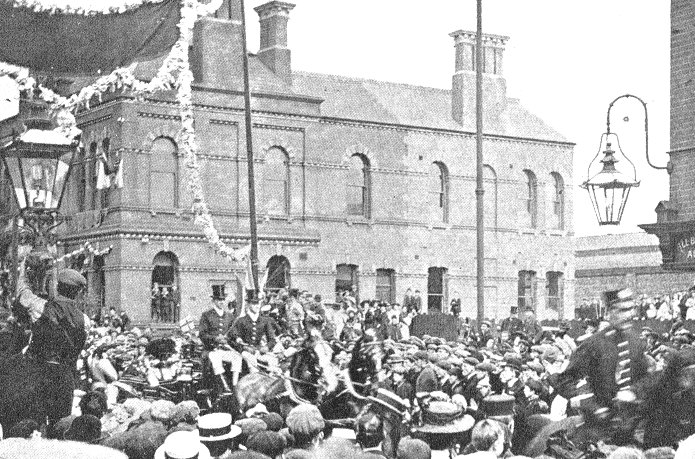
The Public Offices in Owen
Street seen in 1909 during the visit of Queen
Victoria's granddaughter, Princess Marie Louise
of Schleswig-Holstein, who opened a nurses' home
in Lower Church Lane. From an old postcard. |
|
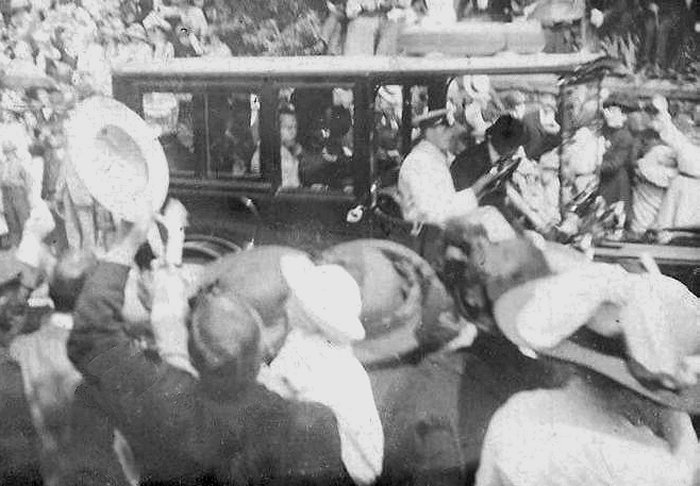
Princess Marie Louise,
travelling through Tipton in 1909. |
|
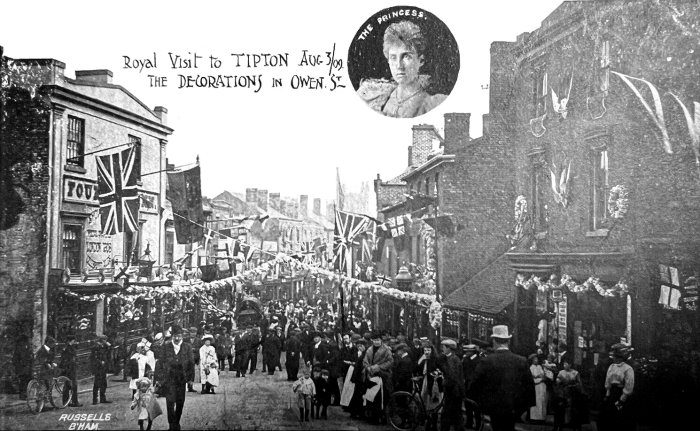
From an old
postcard. |
| Building work on the new Public Offices in Owen
Street began in 1876. The foundation stone was laid
by the chairman of the Local Board of Health, James
Whitehouse, on 13th December, 1876. After the
ceremony a banquet was held at the Navigation Hotel
which stood in Park Lane West. The new building was
erected at a cost of £4,000. It was designed by
Charles Round and Henry Beddoe of Tipton, and built
by David Stockton & Son of Oldbury. The building
contained the council chamber and offices for the
Clerk, the Surveyor, the Sanitary Inspector, the
Medical Officer, and the Collector. Meetings of the
Board were held on the evening of the last Tuesday
each month. The Public Offices continued in use for
59 years until they became part of the Fire Station.
They were demolished in 1972. Tipton parish was divided into six wards in
February 1878 to provide improved representation for
all parts of the town. The wards and the number of
representatives were as follows:
Tipton Ward - six representatives
Tibbington Ward - three representatives
Ocker Hill Ward - three representatives
Toll End Ward - three representatives
Horseley Heath Ward - six representatives
Dudley Port Ward - three representatives |
The number of representatives was loosely based
on population:
Tipton. 9,220
Tibbington and Princess End. 3,130
Dudley Port, Horseley Heath and Great Bridge.
12,310
Ocker Hill, Lea Brook and Toll End. 5,340 |
The Chairman of the Board in 1878 was Mr. Daniel
Hipkins. There were six committees: Finance;
Highway, Sewage and General Purpose; Cemetery and
Hospital; Gas and Stores; Fire Appliances; and Free
Library.
In 1894 under the terms of the Local Government
Act, 1894, the Local Board of Health became Tipton
Urban District Council. The Urban district covered
an area of 2,167 acres.
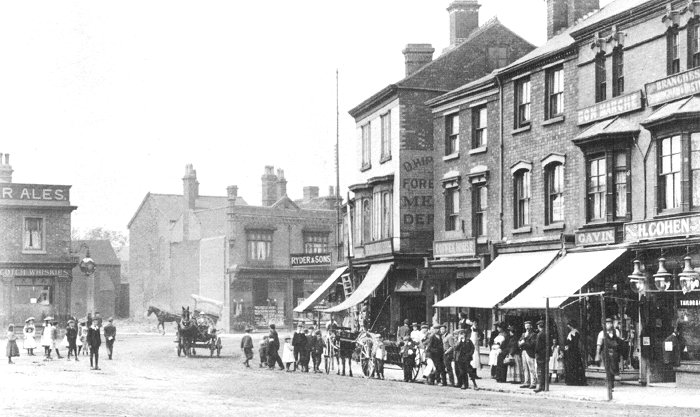
Great Bridge Market
Place. From an old postcard.
The Municipal Buildings
By 1935, space was in short supply at the Public
Offices in Owen Street and so the council purchased
a much larger building in Sedgley Road West from
Beans Industries, which had been built in the 1920s
as an office block. After refurbishment, the
building reopened in 1936 as the Municipal Buildings
and the council chamber and the council’s staff
moved there from the Public Offices.
The Local Government Act of 1933, which came into
operation on 1st June, 1934, allowed urban district
councils to apply for a Charter of Incorporation. On
27th July, 1936 the council applied to the Privy
Council and in 1938 a Royal Charter was granted. The town
then became the Municipal Borough of Tipton,
which was the highest form of local government that
the town could achieve.
|
|
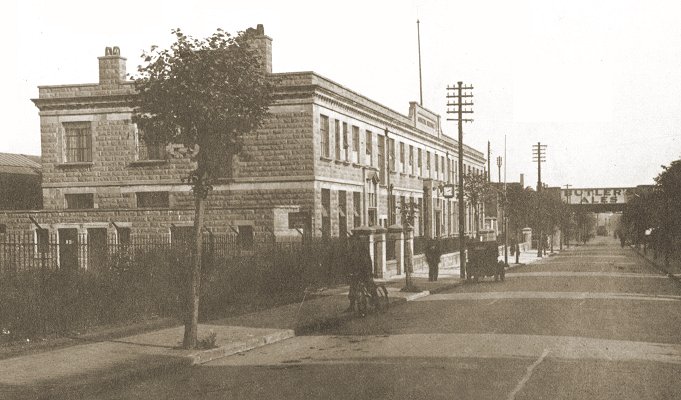
The Municipal Buildings in
Sedgley Road West. From an old postcard. |
|
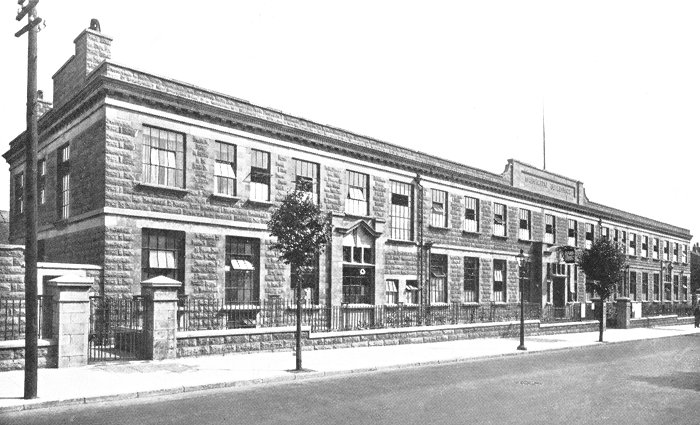
Another view of the
Municipal Buildings. |
|
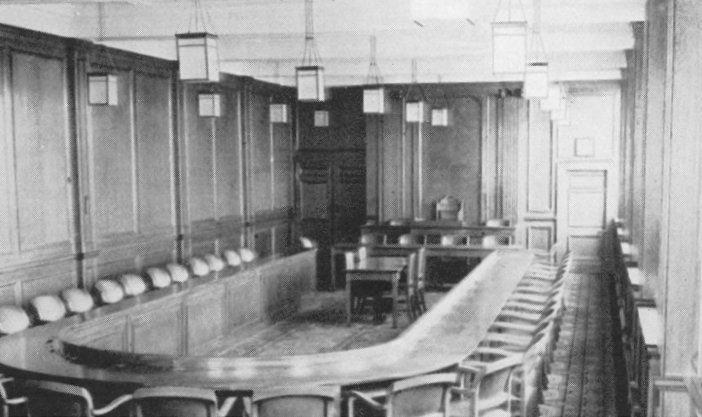
The Council Chamber. |
|
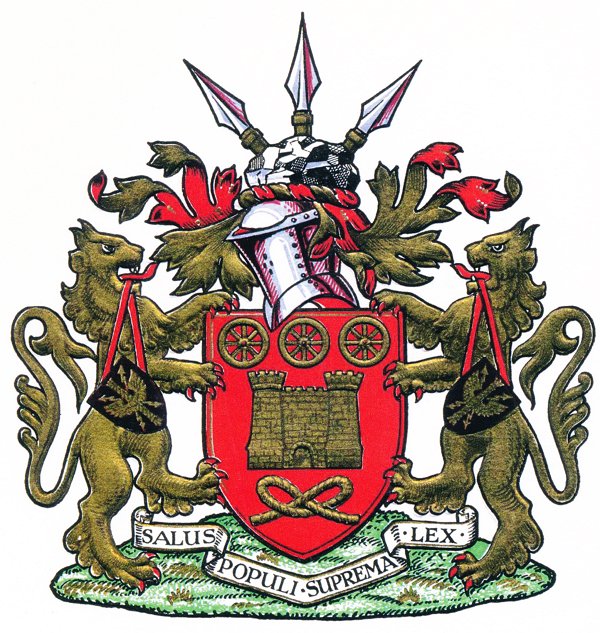
The Coat of Arms of the
Municipal Borough of Tipton. |
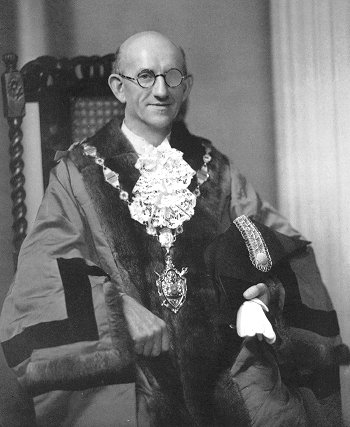 |
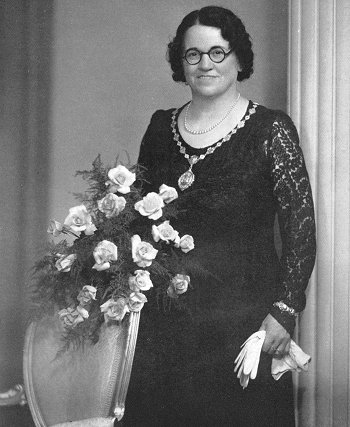 |
|
The Mayor
and Mayoress in 1938. Councillor
A. F. Welch, J.P. and Mrs.
Welch. |
|
|
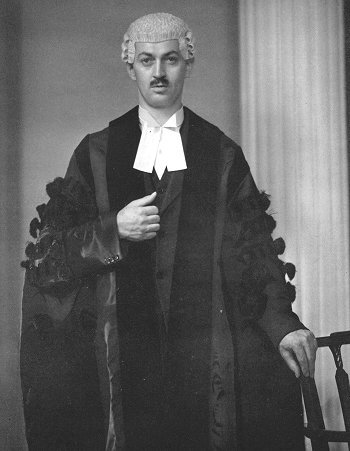
The Town Clerk in
1938. Kenneth W. Madin. |
On 1st April, 1966, under the terms of the Local
Government Reform Act, Tipton lost its status as a
Municipal Borough and came under the direct control
of West Bromwich Borough Council, as did Wednesbury. On 1st April, 1974, Sandwell Metropolitan Borough was
formed with the merger of West Bromwich and Warley
Borough Councils. The new borough includes six Black
Country towns: Oldbury, Rowley Regis, Smethwick,
Tipton, Wednesbury, and West Bromwich.
As a result of the boundary changes, a small part
of Tipton including the Municipal Buildings and most
of the Foxyards housing estate became part of the
Metropolitan Borough of Dudley and much of the
Tividale area became part of the County Borough of
Warley. A small section of Coseley around Princes
End became part of Tipton.
The Municipal Buildings soon became part of
Dudley College and remained so until 1993. The
building was then occupied by a number of
businesses, but is now (in 2018) empty. |
|
Chairmen of Tipton Local
Board of Health |
|
1855 to 1857 |
|
Reverend William Kerr |
|
1858 to 1869 |
|
William Howells |
|
1870 to 1874 |
|
William
Lees Underhill |
|
1875 to 1884 |
|
James
Whitehouse |
|
1885 to 1888 |
|
Edward Bayley |
|
1889 to 1894 |
|
Daniel Hipkins |
|
Chairmen of Tipton Urban
District Council |
|
1895 to 1897 |
|
Daniel Hipkins |
|
1898 |
|
Clement H. Barrows |
|
1899 |
|
Daniel
Hipkins |
|
1900 |
|
Thomas Crew |
|
1901 to 1902 |
|
Daniel Hipkins |
|
1903 |
|
George S. Peake |
|
1904 |
|
James W. Dudley |
|
1905 to 1907 |
|
Joseph Powell |
|
1908 |
|
Richard Mason |
|
1909 |
|
Thomas E. Salter |
|
1910 |
|
William A. Robbins |
|
1911 |
|
Joseph Powell |
|
1912 |
|
John A. Shephard |
|
1913 |
|
William J. W. George |
|
1914 |
|
Thomas E. Salter |
|
1915 to 1916 |
|
George S. Peake |
|
1917 to 1921 |
|
William Woolley Doughty |
|
1922 |
|
Thomas E. Salter |
|
1923 to 1924 |
|
William Woolley Doughty |
|
1925 to 1927 |
|
William H. Powis |
|
1928 to 1930 |
|
John W. Bourne |
|
1931 |
|
Arthur E. Bannister |
|
1932 |
|
Joseph R. Baker |
|
1933 |
|
William J. W. George |
|
1936 |
|
Arthur Frederick Welch |
|
1937 |
|
Sidney Davis |
|
Mayors of Tipton
Municipal Borough
Council |
|
1938 to 1939 |
|
Arthur Frederick Welch |
|
1940 to 1943 |
|
William Henry Powis |
|
1944 to 1946 |
|
Arthur Jones |
|
1947 to 1950 |
|
William Edward Hampton |
|
1951 to 1953 |
|
Arthur Edwin Bolton |
|
1954 |
|
Hannah Geneva Cox |
|
1955 |
|
Sidney Hall |
|
1956 |
|
James Gill |
|
1957 |
|
William Horace Hirons |
|
1958 to 1959 |
|
John William Walters |
|
1960 to 1961 |
|
Albert Morton |
|
1962 |
|
John
William Walters |
|
1963 |
|
Frank Austin Chamberlain |
|
1964 |
|
William Eric Drew |
|
1965 |
|
Jonah Whitehouse |
|
| |
|
Read
about the development
of Tipton's Libraries |
 |
| |
|
| Tipton has rapidly grown from a small village to
today’s large urban area, as can be seen from the
following population figures: |
|
1801 4,288
1811 8,407
1821 11,546
1831 14,951
1841 18,891
1851 24,853
1861 28,870
1871 29,445
1881 30,013
1891 29,316
1901 30,543
1911 31,756
1921 34,131
1931 35,814
1938 37,000 (approximate)
By 2011 the population had increased to 38,777.
|
|
 |
 |
 |
|
Return to
Roads
and Railways |
Return to
the
beginning |
Proceed to
Victoria Park |
|